Categories
- Antiques & Collectibles 13
- Architecture 36
- Art 48
- Bibles 22
- Biography & Autobiography 813
- Body, Mind & Spirit 142
- Business & Economics 28
- Children's Books 14
- Children's Fiction 11
- Computers 4
- Cooking 94
- Crafts & Hobbies 4
- Drama 346
- Education 46
- Family & Relationships 57
- Fiction 11829
- Games 19
- Gardening 17
- Health & Fitness 34
- History 1377
- House & Home 1
- Humor 147
- Juvenile Fiction 1873
- Juvenile Nonfiction 202
- Language Arts & Disciplines 88
- Law 16
- Literary Collections 686
- Literary Criticism 179
- Mathematics 13
- Medical 41
- Music 40
- Nature 179
- Non-Classifiable 1768
- Performing Arts 7
- Periodicals 1453
- Philosophy 64
- Photography 2
- Poetry 896
- Political Science 203
- Psychology 42
- Reference 154
- Religion 513
- Science 126
- Self-Help 84
- Social Science 81
- Sports & Recreation 34
- Study Aids 3
- Technology & Engineering 59
- Transportation 23
- Travel 463
- True Crime 29
English Walnuts What You Need to Know about Planting, Cultivating and Harvesting This Most Delicious of Nuts
by: Walter Fox Allen
Categories:
Description:
Excerpt
Foreword.
Realizing the tremendous interest that is now being directed by owners of country estates everywhere to the culture of the Persian or English Walnut, I have compiled this little book with the idea of supplying the instruction needed on the planting, cultivation and harvesting of this most delicious of all nuts.
I have gathered the material herein presented from a large number of trustworthy sources, using only such portions of each as would seem to be of prime importance to the intending grower.
I am indebted to the United States Department of Agriculture and to numerous cultivators of the nut in all sections of the country.
I have aimed at accuracy and brevity—and hope the following pages will furnish just that practical information which I have felt has long been desired.
The Compiler.
English Walnuts.
Viewed as a comparatively new industry, the culture of the Persian or English Walnut is making remarkable strides in this country. Owners of farms and suburban estates everywhere are becoming interested in the raising of this delicious article of food, thousands of trees being set out every year.
There are two important reasons for the rapidly growing enthusiasm that is being manifested toward the English Walnut: First, its exceptional value as a food property is becoming widely recognized, one pound of walnut meat being equal in nutriment to eight pounds of steak. Secondly, its superior worth as an ornamental shade tree is admitted by everyone who knows the first thing about trees. For this purpose there is nothing more beautiful. With their wide-spreading branches and dark-green foliage, they are a delight to the eye. Unlike the leaves of some of our shade trees, those of this variety do not drop during the Summer but adhere until late in the Fall, thus making an unusually clean tree for lawn or garden. In addition to all this, the walnut is particularly free from scale and other pests.
Up to the present time, the English Walnut has been more largely in demand as a shade tree than as a commercial proposition; in fact, so little attention has been given to the nuts themselves that there are, comparatively speaking, few large producing orchards in the United States, the greater portion of the total yield of walnuts being procured from scattered field and roadside trees. It is a little difficult to understand why they should have been so neglected when there are records of single trees bearing as much as 800 pounds of nuts in one year.
Six Year Old Bearing English Walnut Tree
In 1895 this country produced about 4,000,000 pounds, and more than 16,000,000 pounds of English Walnuts in 1907, with a proportionate annual increase each year to the present. But, when it is known that the United States is consuming yearly about 50,000,000 pounds of nuts, with the demand constantly increasing, thereby necessitating the importation annually of something more than 25,000,000 pounds, the wonderful possibilities of the industry in this country, from a purely business view point, will readily be appreciated....


